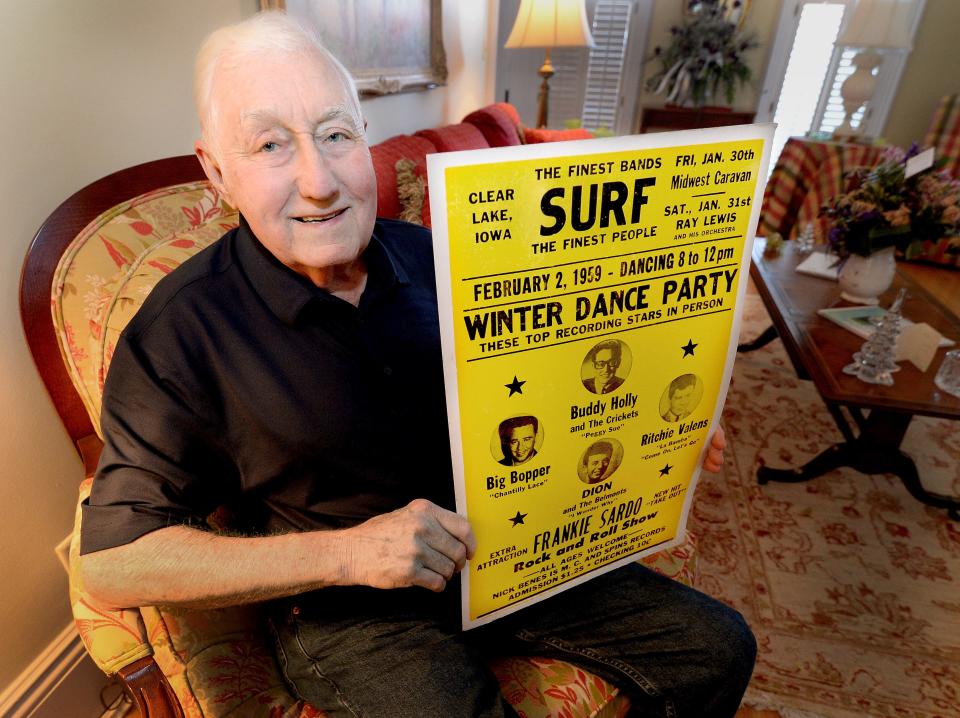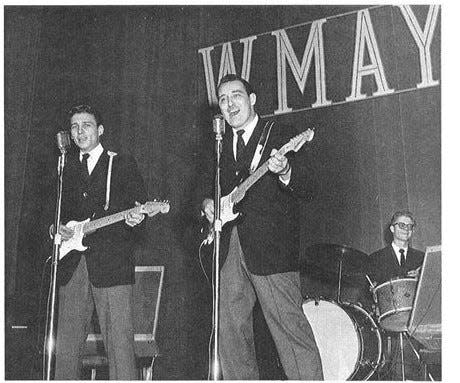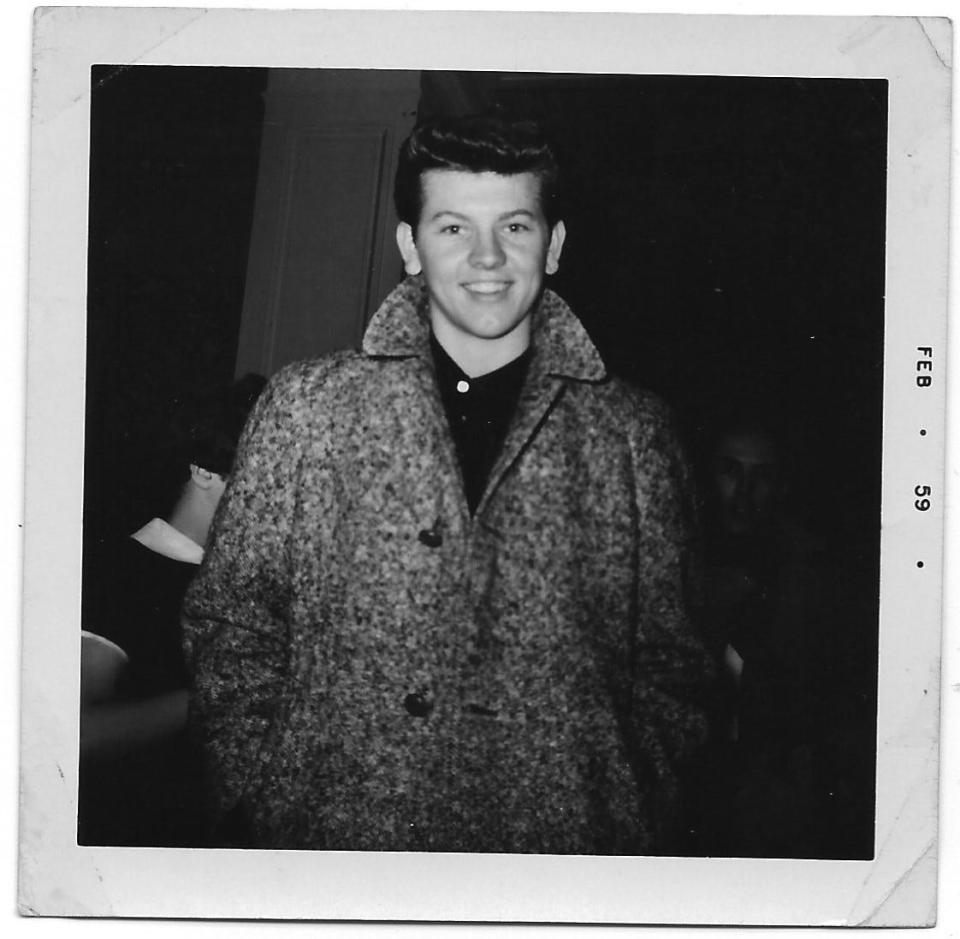65 years later: Anniversary of Springfield concert looks back on 'the day the music died'
Tris Schnepper said he was devastated when he heard the news that Buddy Holly was killed in a plane crash in the early morning hours following his Feb. 2, 1959, performance at the Surf Ballroom in Clear Lake, Iowa.
Holly was one of the main reasons Schnepper, then a 17-year-old Beardstown High School senior, bought tickets for his date and him to the Feb. 15 show at the Illinois State Armory in Springfield, the scheduled last stop on the "Winter Dance Party" tour.
Without Holly and two other performers killed in the crash, Ritchie Valens and J.P. Richardson Jr., "The Big Bopper," Schnepper figured the two shows in Springfield would be cancelled.
So, Schnepper was surprised that the tour pushed on with a reconfigured lineup that included headliner Fabian and tour holdovers Dion and the Belmonts and Holly's backing band, The Crickets, including a young bassist named Waylon Jennings, among others.
The Springfield shows were billed as "Shower of Stars" and WMAY radio station broadcast the concerts.
"I liked them all," said Schnepper, reflecting on the acts at the packed matinee show staged 65 years ago Feb. 15. "Each one was the greatest as they performed."
Playwright hopes original work about 1908 race riot can jumpstart conversations

The deaths of Holly, Valens and Richardson came to be known as "the day the music died," and was memorialized by Don McLean in "American Pie."
Canadian Sevan Garabedian, who co-produced a documentary about the "Winter Dance Party," is now working on a separate book project on the post-crash shows, like Springfield and Peoria, where they played the night before.
Now 82, Schnepper, who lives in Rochester and has three grown children and nine grandchildren, has remained a fan of early rock 'n' roll, and particularly Holly.
Schnepper got a little taste of what that 1959 concert might have looked, sounded and felt like when "Winter Dance Party 2000" stopped at the Masonic Temple in Springfield with Chicago-born actor John Mueller in the role of Holly. Schnepper said he's seen Mueller's act multiple times since.
Schnepper said McLean captured the time perfectly. For him, music was never the same.
"It was an age of innocence," Schnepper said, "and that seemed to go (after Holly's death)."

'A boy-crazy 14-year-old'
As a teenager growing up in the Logan County village of Latham (population 200), Phyllis (Curry) Draper would try to pull in radio stations WMAY and WLS in Chicago on her transistor radio.
Both played rock 'n' roll and Draper fell hard for the music.
"I leaned more towards Ricky Nelson and Elvis Presley," said Draper, 78, who now lives in Dunlap, just outside of Peoria. "Buddy Holly I liked. Dion and the Belmonts."
Draper said she couldn't recall how she got tickets to the "Shower of Stars" show, only that she talked a friend into going and begged her father to drive them to Springfield.
"There was a lot of noise and hype and excitement," recalled Draper about the show. "I couldn't keep myself seated. I remember rows and rows and rows of folding chairs and when you're from Latham and you go to the Armory, you look around and go, 'Oh, my gosh, look how big this place is.' I was already out of my comfort zone, but I was so hopped up on seeing somebody famous and we pushed as far as we could to get a seat. "
Afterwards, Draper snapped photos of Fabian and Jimmy Clanton ("Just A Dream") in the lobby of the Hotel Abraham Lincoln at Fifth and Capitol.
Draper said she knew at the time Holly had died in a plane crash, but the importance of the show didn't resonate with her until years later when she met and talked to Garabedian.

"I was a boy-crazy 14-year-old. What do I care?" Draper joked. "I really have a great respect for that history (now). I still want to know and read more because I didn't know at the time that I was experiencing part of history. That didn't sink in."
After graduating from high school in 1963, Draper moved to Springfield, where she lived for 10 years. She later worked as an administrative secretary for the city of Peoria.
Draper, who has five grandchildren and great-children, still listens to '50s music "but I really perk up on Jimmy Clanton and Dion and the Belmonts. When I hear them on the radio, I sing along. I'm dancing, just like then."
'You want to believe'
Garabedian wasn't even alive when the "Winter Dance Party" tour took place, but he has spent two decades researching it and has done 60-plus interviews with people who saw the Springfield shows.
The Montreal resident said he understood the pain concertgoers like Schnepper felt, a once-in-a-lifetime opportunity to see a rock 'n' roll star like Holly, only to have it ripped it away.
"It broke a lot of hearts," said Garabedian, in a recent phone interview. "A lot of (fans) remember how they heard about the plane crash, just like where they were when President (John F.) Kennedy got assassinated. It's one of those moments in time."
The tour, in Garabedian's estimation, symbolized the end of an era.
"Everything changed," he said. "Photos of kids with the artists, not only in Springfield, but from all the shows, it showed how close the rock 'n' roll stars were at the time. They had no airs about who they were. And that all changed in the '60s, with the big arena shows and the travel. Everything got bigger.
"The music really did die for quite a few years. It was dormant until the Beatles showed up."
Schnepper said as much as he enjoyed the "Shower of Stars" show that did take place, he collected memorabilia about the tour, and it turned him into an even bigger Buddy Holly fan.
He has even read "The Winter Dance Party Murders," a fictionalized account by Greg Herriges that claimed the U.S. government took the plane down to help end rock 'n' roll. In the book, Holly survived the plane crash and went to England to recuperate, only to come back as John Lennon.
"Instead of having the Crickets, he had the Beatles," said Schnepper, picking up the story. "He kept this up for a while, but he decided to tell the truth and the day he was going to do the press conference was the day he was shot (in 1980)."
When "Winter Dance Party 2000" came to Springfield, Schnepper pointed out to his wife, Debbie, who died in December, that he had waited 40-plus years for it come around.
"You think you were watching Buddy Holly," Schnepper recalled. "(John Mueller had) the mannerisms, the sounds, the speech.
"(Those concerts) did take me back to the 1959 show. Part of it is probably your mind. You want to believe."
Sevan Garabedian is looking to talk to people who were at the "Shower of Stars" shows or attended any of the "Winter Dance Party" concerts on the 1959 tour. He is also looking for pictures and autographs from the shows. You can reach him at 514-970-1959 or [email protected].
Contact Steven Spearie: (217) 622-1788; [email protected]; X, twitter.com/@StevenSpearie.
This article originally appeared on State Journal-Register: Buddy Holly's death before Springfield concert ended 'age of innocence'
